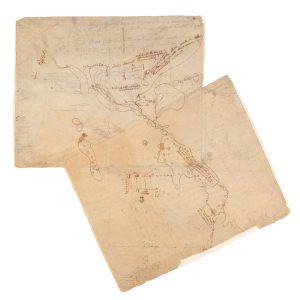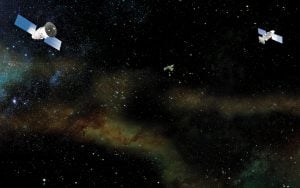
People & Culture
Renaming places: how Canada is reexamining the map
The history behind the Dundas name change and how Canadians are reckoning with place name changes across the country — from streets to provinces
- 4574 words
- 19 minutes
People & Culture
Deep, Dark and Dangerous explores the fascinating story of how British Columbia became a world leader in the underwater tech industry — and the individuals who made it happen
What do submarines, Newsuits and underwater robotics have in common? The answer: British Columbia.
In her newest book, Deep, Dark and Dangerous, Vickie Jensen explores the captivating story of how B.C. has become a world leader in the undersea tech industry. Jensen spent four years researching, then interviewing these underwater trailblazers to tell their remarkable stories.
The author grew up in a small rural town in landlocked Iowa where she was as far from the ocean as one could possibly get. Her father had been in World War Two and didn’t talk much about his experience except for one instance where he spoke about his time as a hard-hat diver while in the navy. Jensen was fascinated by these stories — watched Sea Hunt (a popular 1950s TV series about a navy diver) avidly and dreamed of having a pair of magic glasses that would let her see underwater.
In a recent interview with Canadian Geographic, Jensen, who is a Fellow of the Royal Canadian Geographical Society, discusses the inspiration for her 14th book, the messages she hopes to share and what findings shocked her.
The inspiration in a roundabout way was getting this wonderful job of editing a brand-new maritime trade journal in B.C. called Westcoast Mariner. Every month for four years, I went on a different kind of coastal work boat. Tugboats, dredges, car ferries and charter boats — any working boat aside from a fishing boat, because we had a sister publication called West Coast Fishermen. You would just learn. It was like just being dropped into the pot; you just learned intensively and it was an opportunity.
I was comfortable working in what was predominantly a male environment then, interviewing those guys about what it was like to work on a dredge or what it was like to work on Coast Guard. I tried to give our readers that experience and that was just wonderful training for this book.
Then one day, one of the readers of Westcoast Mariner came to me and said, “Okay, you write about everything that happens on the water, but what’s happening under the water?” And I was speechless. That was Harry Bohm, who became co-author with me on subsequent publications. He was the lab manager for Simon Fraser University’s underwater research lab at the time and he introduced me to the wonderful world of submersibles.
One of the main frustrations was that everybody I interviewed also recommended more people to talk to. I really pushed the word limit and the photo limit on this book. And there were so many people that we found out about afterwards that I would’ve loved to have been included. This is a big industry.
As well, many people were recounting things that happened 40-50 years ago so sometimes versions varied and you had to reconcile that. There were occasional differences of opinions — sometimes strong differences of opinions — and I had to figure that out and work it out. But mostly, it was just a delight for people who were so excited and honoured that the story was going to be told.
I guess one of the readers summed it up perfectly. He said, “These guys are real Canadian heroes but nobody knows about them.” These people are doing amazing stuff underwater! Space gets a lot of coverage, and underwater exploration gets very little. And B.C. isn’t the only place this is happening. Memorial University in Newfoundland has wonderful programs and there are certain universities and technical colleges that are preparing people to work in this field.
Today we are taught to avoid problems. But these guys had problems coming at them all the time. And so, they saw a problem as an opportunity. Sometimes it was an opportunity to devise a new invention and find a different way to do something. They weren’t afraid of failure because they were trying stuff that was so new. They learned from their failures and kept going. There was the value of hard work and the joy of problem-solving and exploration that you have to keep your sense of humour.
Well, I go back to something I didn’t realize until I started writing this book — that the commercial diving revolution that took place in the 50s is very similar to what we’re facing today. In the 1950s, the working depths for a commercial diver went from less than 100 feet to 1,000 feet in a decade. And part of that was the push for oil drilling offshore. That push to go deeper and do more was getting people killed but it was also getting so much exploration done. And it was big money, you know. Very typically, $1,000 a minute and so there was big pressure to make it work and get it happening.
That same push to go deeper was also true for subsea crafts. So, we went from small submersibles to ROVs (remotely operated vehicles), which were unmanned explorers and then to AUVs (autonomous underwater vehicles), which didn’t have the tether, and then to cable seafloor observatories. And now we have fleets of tiny Argo floats and solar-powered gliders and other craft that operate independently for long periods of time. So, that’s all happened in a very short period of time.
In the future, I think we’ll see more data transfer. And lighter-weight materials are always coming online and that makes a huge difference because it just takes less power. New types of materials in technology, alternative power sources and better battery storage capability will allow equipment to operate longer. Modular construction which is really important when you’re moving things for their flexibility and adaptability. The miniaturization and equipment that can transform to fit into extremely tight space limitations in job requirements. That’s happening in space but also underwater and those two industries are very similar in respect.
The more data we collect, the greater the global awareness we have in terms of the role that oceans play in our planet’s balance. We have to be aware that the ocean is not the garbage dump it was once considered to be and that there’s so much more going on down there.
Just how tough it is to work underwater. People talk about how tough it is in space, but underwater the sense of pressure is so ominous and dangerous and a force to be reckoned with. It’s also doggone deep and doggone dark. The determination and willingness of people to do this work was pretty remarkable to me.




















People & Culture
The history behind the Dundas name change and how Canadians are reckoning with place name changes across the country — from streets to provinces

People & Culture
The story of how a critically endangered Indigenous language can be saved

People & Culture
*It means “awake” in Beothuk, the language and people who once called present-day Newfoundland home for about 2,000 years. One young woman, believed to be the last living Beothuk, left a collection of maps and art that help us understand her people’s story.

Science & Tech
As geotracking technology on our smartphones becomes ever more sophisticated, we’re just beginning to grasps its capabilities (and possible pitfalls)